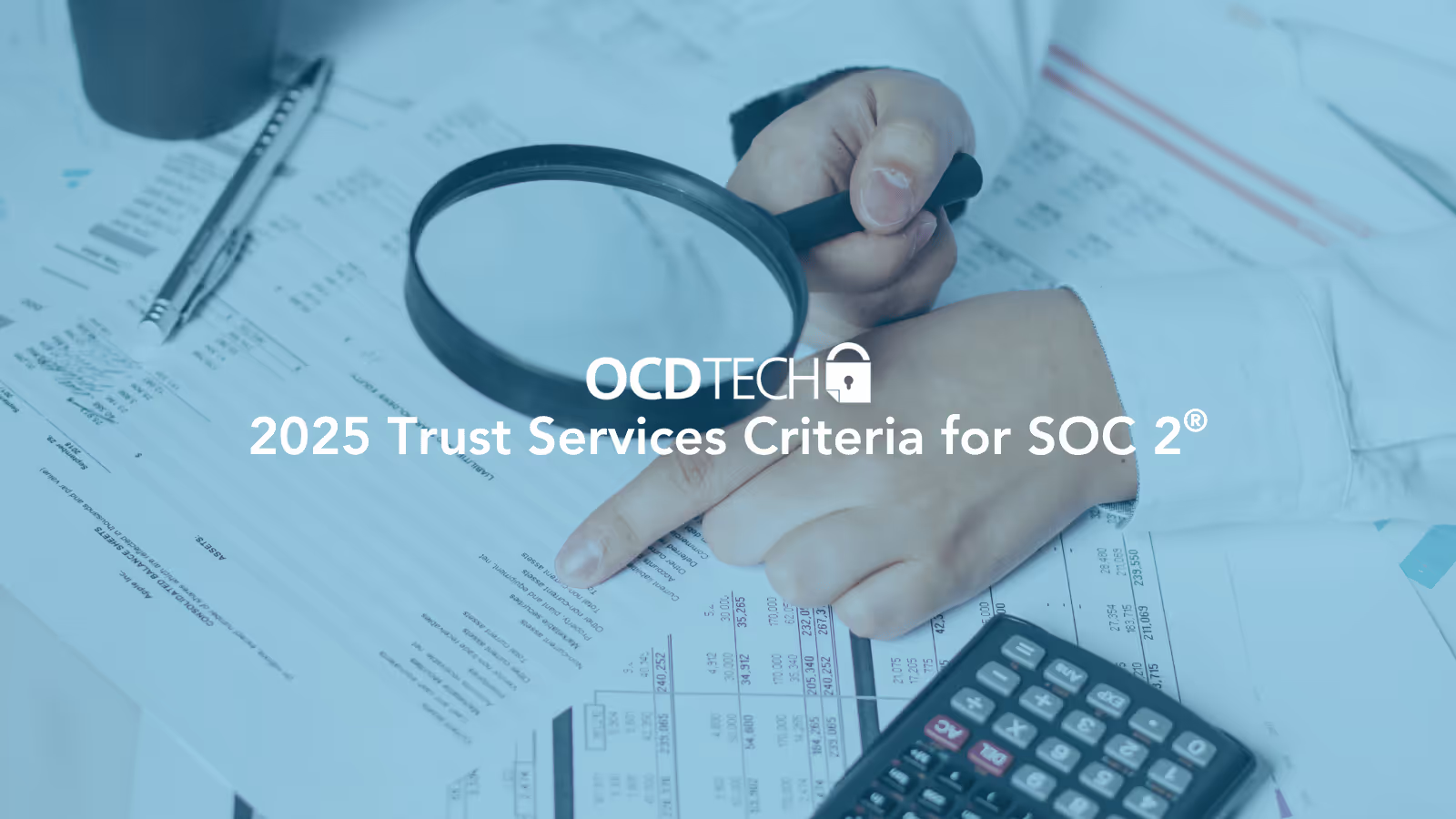By
OCD Tech
•
2
min read

In the dynamic world of data security and privacy, businesses are increasingly expected to demonstrate their commitment to safeguarding information. One way they do this is through SOC 2 compliance, a widely recognized standard. As we look towards 2025, understanding the Trust Services Criteria for SOC 2 becomes crucial for organizations aiming to maintain or achieve compliance.
SOC 2, short for Service Organization Control 2, is a framework developed by the American Institute of CPAs (AICPA). It sets the criteria for managing customer data based on five "trust service principles": security, availability, processing integrity, confidentiality, and privacy.
SOC 2 reports are unique to each organization, as they are tailored to the specific services provided. The reports are intended for use by stakeholders, like business partners and regulators, to gain confidence in a company's data handling practices.
SOC 2 compliance is more than just a checkbox. It demonstrates a company's dedication to maintaining a high standard of data security, which in turn builds trust with clients and partners. As cyber threats continue to evolve, having a SOC 2 report can significantly enhance your business's reputation and competitive edge.
By obtaining a SOC 2 report, companies showcase their commitment to protecting customer data. This reassures clients that their information is handled with care and in accordance with industry standards. In an era where data breaches are all too common, this trust can be a significant differentiator.
A SOC 2 report not only instills confidence in existing clients but also attracts new business. Many organizations require their partners to have SOC 2 compliance as a prerequisite. Thus, having this certification can open new doors and opportunities.
The Trust Services Criteria are the foundation of the SOC 2 framework. As we approach 2025, these criteria are expected to evolve to address emerging challenges and technological advancements. Here's a closer look at each of the five principles:
Security is the cornerstone of the Trust Services Criteria. It ensures that the system is protected against unauthorized access. Measures include firewalls, intrusion detection systems, and multi-factor authentication. In 2025, expect an increased emphasis on advanced security technologies like artificial intelligence and machine learning to predict and mitigate threats.
This principle focuses on the system's accessibility. It ensures that services are available for operation and use as committed or agreed upon. As remote work becomes more prevalent, systems must be robust against disruptions. Future criteria may emphasize resilience against both physical and digital threats to maintain uptime and reliability.
Processing integrity ensures that system processing is complete, valid, accurate, timely, and authorized. Businesses will need to invest in advanced data processing techniques and regular audits to ensure their systems meet these criteria and maintain high standards of reliability.
Confidentiality pertains to the protection of information designated as confidential. This includes implementing encryption protocols and access controls. As global data privacy regulations become stricter, maintaining confidentiality will be critical for demonstrating compliance and protecting sensitive information.
Privacy addresses the organization۪'s collection, use, retention, disclosure, and disposal of personal information. With increasing data privacy concerns, organizations must be transparent about their data handling practices. This could involve adopting comprehensive privacy policies and user consent mechanisms that align with evolving international standards.
Achieving SOC 2 compliance requires a structured approach. Here are the essential steps to guide your organization:
While SOC 2 compliance is highly beneficial, organizations often face challenges during the process:
As we move towards 2025, SOC 2 compliance will continue to play a pivotal role in establishing trust and credibility in the business landscape. By understanding and implementing the Trust Services Criteria, your organization can not only protect customer data but also enhance its reputation and competitive advantage.
Staying proactive and adapting to these criteria will ensure that your organization remains a trusted partner in an increasingly digital world. Whether you're just starting your SOC 2 journey or renewing compliance, the key is to treat it as an ongoing commitment to excellence in data security and privacy.

Audit. Security. Assurance.
IT Audit | Cybersecurity | IT Assurance | IT Security Consultants – OCD Tech is a technology consulting firm serving the IT security and consulting needs of businesses in Boston (MA), Braintree (MA) and across New England. We primarily serve Fortune 500 companies including auto dealers, financial institutions, higher education, government contractors, and not-for-profit organizations with SOC 2 reporting, CMMC readiness, IT Security Audits, Penetration Testing and Vulnerability Assessments. We also provide dark web monitoring, DFARS compliance, and IT general controls review.
Contact Info
.svg)
OCD Tech
.svg)
25 BHOP, Suite 407, Braintree MA, 02184
.svg)
844-623-8324
.svg)
https://ocd-tech.com
Follow Us
Videos
Check Out the Latest Videos From OCD Tech!
Services
SOC Reporting Services
– SOC 2 ® Readiness Assessment
– SOC 2 ®
– SOC 3 ®
– SOC for Cybersecurity ®
IT Advisory Services
– IT Vulnerability Assessment
– Penetration Testing
– Privileged Access Management
– Social Engineering
– WISP
– General IT Controls Review
IT Government Compliance Services
– CMMC
– DFARS Compliance
– FTC Safeguards vCISO